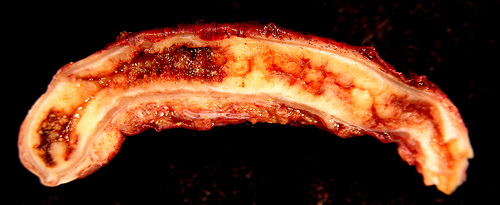Amoebic dysentery (Amoebiasis) is an infection of the large intestine that is caused primarily by a single celled protozoan parasite (amoeba), Entamoeba histolytica. This infection is characterized by amoebic dysentery symptoms, which range from general weakness to stomach ache and severe diarrhea.

Over time, the infection worsens and patients usually pass stool that is laced with blood and mucus, with other complications like mild fever and abdominal pain. The infection is mainly acquired through the ingestion of food or water that’s contaminated with the causative organism. The disease presents itself as mild or often asymptomatic (without any symptoms) in a majority of the cases. If dysentery diagnosis and treatment are not done at the right time, the condition can turn life threatening and in about 20 % of the cases, it does.
Once the organism invades the intestine, amoebic dysentery symptoms appear after an incubation period of 7 to 28 days. This may vary from a few days to even months.
The Two Stages Of Amoebic Dysentery Symptoms
Mild Amoebic Dysentery Symptoms
Most affected individuals start experiencing certain mild amoebic dysentery symptoms during the early stages of the disease. It is important that these signs are noted immediately, so that you can consult a physician at the earliest possible instance.
The early symptoms of amoebiasis include:
- Nausea
- Loose stools
- Stomach pain
- Loose bowel movements with rectal pain
- Stomach cramping
- Lack of appetite
- General weakness
Severe Amoebic Dysentery Symptoms
Blood and mucus (pus) stained feces is an indication of severe amoebic dysentery. This symptom is presented when the parasite multiplies enough to cause ulcers or localized lesions in the large intestine.
The organism may break through the intestinal wall, causing amoebic colitis (inflammation of the colon). Severe disease is associated with abdominal pain and massive diarrhea, with the constant loss of fluid inevitably leading to dehydration. Patient may need to relieve their bowels 10 – 20 times, and streaks of blood will be visibly present in such stool. Other symptoms at this stage include:
- Fatigue
- Excessive gas and abdominal bloating (flatulence)
- Weight loss
- Anemia
- Foul smelling stool
- Intermittent diarrhea and constipation
- Indigestion
- Abdominal swelling and tenderness
- Rectal bleeding
- Localized perforation
- Appendicitis

Extra Intestinal Amoebic Dysentery Symptoms
In rare cases, the causative organisms invade the blood and are carried to other organs of the body, leading to the formation of abscesses (swollen areas within body tissue, containing an accumulation of pus). Such abscesses mainly occur in the liver but may also extend to adjacent areas like the cardiac region. Brain abscesses and genitourinary diseases may also result due to complications.
Symptoms at this later phase include:
- Fever
- Chills
- Nausea
- Vomiting
- Weight loss
- Dry painful cough
- Pain in the upper right part of the abdomen
- Hepatomegaly (enlarged liver)
- Jaundice
Amoebic dysentery symptoms are easy to miss during the early stages. For this reason, it’s doubly important to consult a physician immediately once the primary symptoms manifest.
Are You Prone To Amoebic Dysentery Symptoms?
Amoebic dysentery symptoms are commonly noted in certain regions, and there are many risk factors associated with the disease. People who can contract the disease are:
- HIV/ AIDS patients
- Post-transplant patients
- Travelers who visit developing countries or tropical regions, where amoebic dysentery is prevalent
- Mentally challenged individuals with poor personal hygiene
- Underdeveloped or developing countries, where proper sanitary measures are inadequate
- Heterosexuals/Homosexuals who practice anal intercourse
- The use of corticosteroid medication
- Malnutrition
- Cancer
- Alcoholism
The disease is communicable as long as the organism is excreted in the feces of infected individuals. Some chronic carriers often act as potential dysentery causes by excreting the organism for years without showing any clinical symptoms otherwise. Usually, it is amoebic dysentery symptoms that dictate how critical the case is and what form of amoebic dysentery treatment is ideal for that particular case.